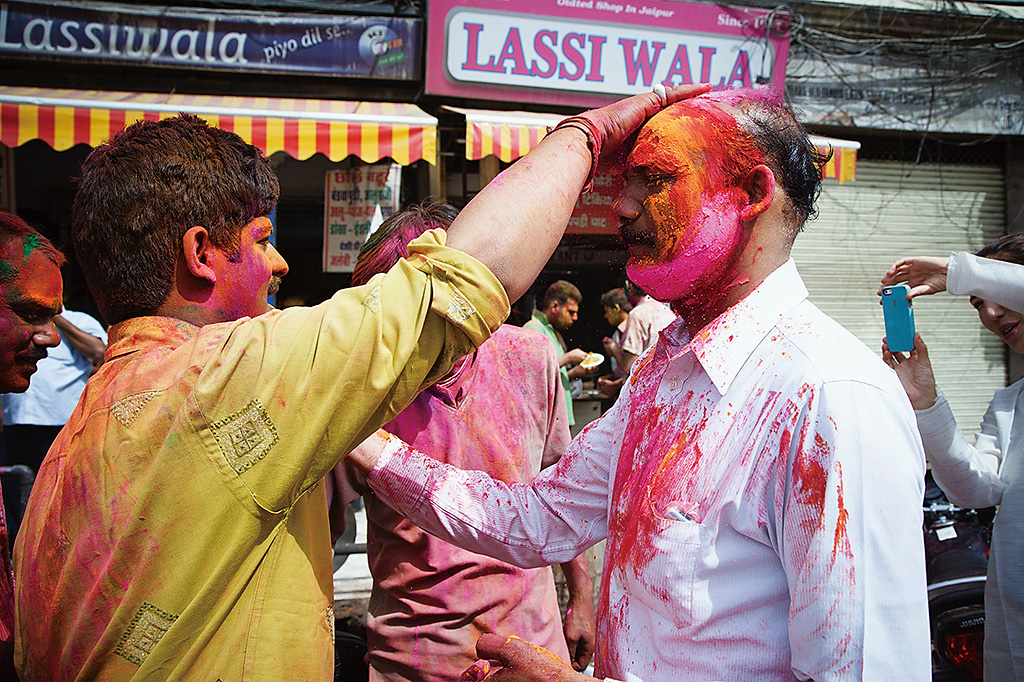Standard Lens Techniques: Using the Point of View to Draw the Viewer In
When attempting to convey a scene as you see it, an excellent way to do so would be by using a standard lens. A good idea would be to select a focal length of around 50mm at 35mm film-equivalent, which is close to the field of view of the naked eye. However, remember to be creative about the shooting position, otherwise you could end up with very run-of-the-mill photos. In this article, I will introduce techniques on how to draw your viewers into any scene you shoot. (Reported by: Takehiko Yagi)

EOS-1Ds Mark II/ EF24-105mm f/4L IS USM/ FL: 47mm/ Aperture Priority AE mode (f/7.1, 1/1,000 sec., EV-1.3)/ ISO 200/ WB: Auto
At the Holi festival in India, participants bless each other by covering each other with coloured powder, while greeting each other with "Happy Holi". Everyone’s skin is coated with so many layers of various coloured powders that it would take more than one shower to really wash everything off.
I took this photo in Jaipur, also known as the Pink City.
Use a standard lens’ natural angle of view to shoot over someone's shoulder
While walking around town during the Indian festival of Holi, I came across a scene in which middle-aged men were covering each other in coloured powder. I wanted to convey the scene of the two men as I saw it, so I chose a standard focal length of 47mm, which is close to that of the naked eye, and captured the scene of the two men as it was.
However, if you shoot from a normal standpoint, your photos will end up looking like tourist snaps that give the impression you are simply viewing the festival as an outsider. I thought about how I could convey a greater sense of immersion into the scene, so I moved behind the man to the left. I took the shot at a distance of about 30cm from the man in front of me so as to express the world completely from the point of view of the man smearing the powder. If you take a shot looking over the shoulder of someone using a standard lens’ natural angle of view, the photo will appear to show that person’s point of view.
In addition, I wanted to vividly depict the person being smeared with the colourful powder at a natural distance, so I set the f-number to 2 stops from maximum aperture, and used a low ISO speed. By using an angle of view close to that of the naked eye offered by a standard lens, you can change the viewing angle to resemble a person’s point of view. In this way, the scene becomes what that person sees, allowing you to take shots that give a sense of immersion.
Point: Move to a distance of about 30cm behind the person
I wanted to convey the atmosphere of the festival, so I moved up close to the subject, to a distance of about 30cm behind them. The different possible shooting positions and focal lengths provides endless possibilities for a zoom lens.

Working with the lens: Standard zoom lenses are convenient when mobility is important
In an environment where it is very dusty and it is impossible to change lenses, you cannot take a lot of lenses with you. It is also best to go light when you are continually taking shots while doing a lot of walking. By selecting a single lens that provides extensive coverage, from wide-angle to medium telephoto, you will be able to handle a variety of situations. Even with such a wide range, I often shoot in the 40 to 50mm range. That is because shooting in this standard range (which is close to that of the naked eye) makes it easier to maintain a sense of tension with the subject, and also creates less distance.
Tip #1: Remember that shooting from a third-person point of view turns your photos into mere tourist snaps
Below is an example of a photo taken from a third-person point of view that looks like a tourist snap. Taken while passing by, this photo gives the feeling that it was taken with restraint. Because this kind of shot gives a weak sense of presence, you should change the angle.

Tip #2: Taking shots over someone's shoulder allows you to capture their point of view
Here is a photo of the Taj Mahal taken from Agra Fort, while looking over someone's shoulder. This was captured with the sightseer’s emotions in mind. It gives the effect of reliving the scene as viewed by the person in the photo.

Lens used: EF24-105mm f/4L IS USM

This lens, which has a focal length ranging from 24mm to 105mm, provides an appealing extent of coverage when you leave the aperture fully open. An all-purpose lens that weighs in at a light 670g, it is easy to carry and reassuring to have when travelling and moving about.

Takehiko Yagi
Born in Fukuoka Prefecture in 1988. Following graduation from university, he worked for a photography studio and later, as a freelancer. He started working as a photographer from 2014.

Digital Camera Magazine
A monthly magazine that believes that enjoyment of photography will increase the more one learns about camera functions. It delivers news on the latest cameras and features and regularly introduces various photography techniques.
Published by Impress Corporation

































